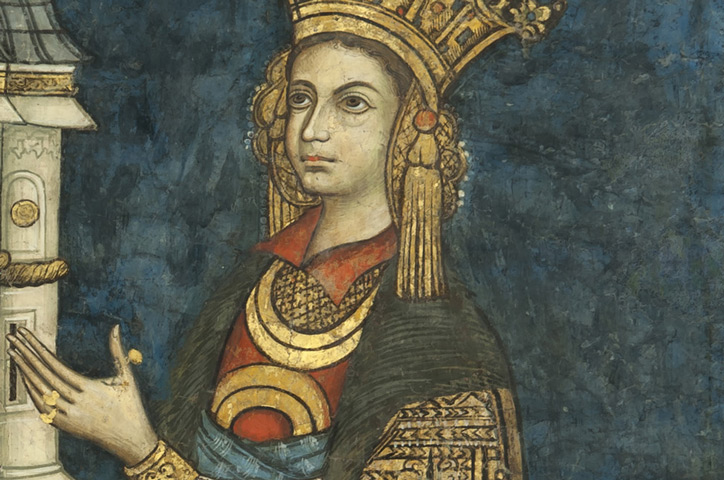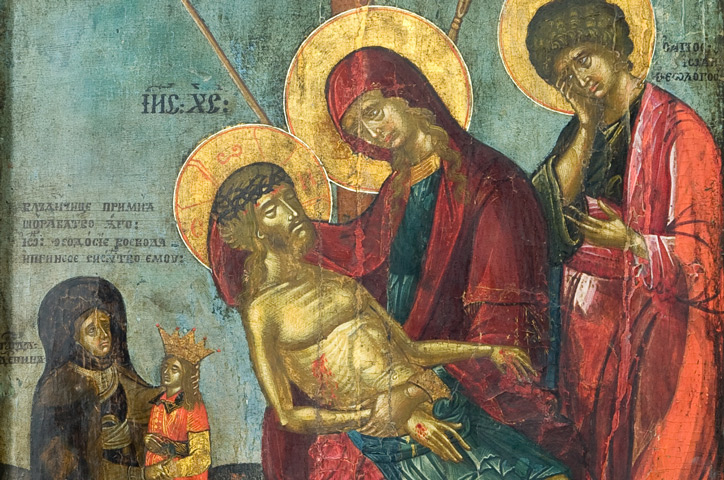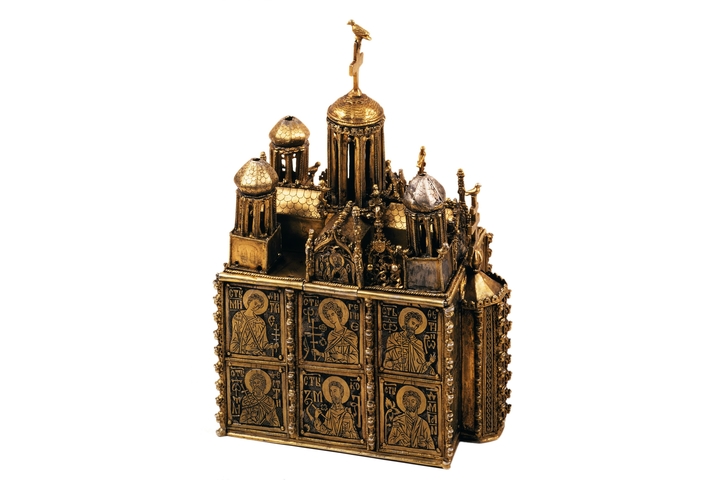Discover the works in the Romanian Medieval Art Gallery
Icon - Saints Constantine and Helena
Toward the end of the 17th century Wallachian ruler Constantin Brâncoveanu (1688 – 1714) supported the restoration and refurbishment of the metropolitan church in Târgovişte, and its iconostasis. Icons newly painted by master Athanasie include that of the Holy Great Emperors Constantine and Helena. When contemplating it, onlookers were reminded of by then legendary histories whose symbolic value was heightened by contemporary context.
The icon represents the two saints in solemn pose on either side of a monumental cross surmounted by a blessing Jesus. Behind them, at the foot of the cross, lies the walled city of Constantinople, the capital of Eastern Christianity. Apart from the signs of earthly power (sumptuous costumes, richly adorned sceptres and crowns), the two saints also wear a pectoral cross representing Jesus crucified (Constantine) and a medallion (engolpion) showing Virgin Mary (Helena) as symbols of their role as Great Hierarchs and leaders of the Church.
Read more: Icon - Saints Constantine and Helena
- Artwork description
- Icon
tempera on wood, gilded background
116 x 81,5 cm
Master painter Athanasie
Wallachia
1699
Inv. 11 791/ i 448 - Artwork location
- Romanian Medieval Art Gallery, room 6
Mural painting - Self-portrait by Pârvu Mutu
The fresco fragment from the church in Bordeşti (Vrancea County) shows a mature man holding a painting brush in his right hand and a shell used to mix colours in his left hand. He is seconded by a younger man who stands behind him. From this we can conjecture this is the portrait master painter Pârvu Mutu, the author of the painting at Bordești. Brush and shell are indicative of his trade, one that had earned him social respectability in a world ready to allow certain master painters to abandon their anonymous status, long time a rule in post-Byzantine tradition.
Portraits such as this signal substantial changes underway as stronger professional guilds and an increasingly more nuanced layering of Romanian society slowly replaced the medieval mentality.
Read more: Mural painting - Self-portrait by Pârvu Mutu
- Artwork description
- Fragment from the church in Bordeşti
Pârvu Mutu (1657 – 1735)
Mural ‘a fresco’ painting
105 x 104 cm
Wallachia 1699
Inv. 1513 - Artwork location
- Romanian Medieval Art Gallery, room 6
The Iconostasis of the Cotroceni Monastery
The Cotroceni monastery was built by Prince Şerban Cantacuzino (1678 - 1688) during the early years of his reign. The church was provided with an ample, impressive, richly adorned iconostasis that separated the altar from the nave where the sacrament of the holy Eucharist takes place. This is in line with a tradition codified in the 16th century to synthetically and symbolically represent a pictorial rendition of the history of divine revelation, Christian mystery, and the role of the Church and ordained priests in perpetuating it. The congregation contemplates what is actually performed behind the icon screen.
The supporting wall, carved by a local workshop, shows the Tree of Jesse. From the reclining figure of Jesse at the centre of the lower decorative tier surmounting the Royal Doors, grows a vine whose foliage spreads and swirls covering the entire wall. It tells of Jesus’ lineage from the House of David. Constantinos, a master painter formed in the post-Byzantine tradition, was commissioned the icons. His painting relies on strong, vibrating contrasts of red, blue and green that emphasize the glittering light of the gilded backgrounds.
In the lower part of the iconostasis are the Royal Doors symmetrically framed by four large icons. The last to the right shows the ‘Dormition of the Mother of God’, the patron feast specifically celebrated at the Cotroceni church.
Read more: The Iconostasis of the Cotroceni Monastery
- Artwork description
- Iconostasis
Wood carving and tempera painting on wood
Wallachia
1682 - Artwork location
- Romanian Medieval Art Gallery, room 5
- Sign language video
- Sign language video
Anonymous painter - Boyar Manolache Manu
Slightly gauche and obsolete even as it was painted, the portrait of Boyar Manolache Manu writes a page in the visual history of Romanian society in the first half of the 19th century.
At the time, Manolache Manu was a member of the Moldavian government, his rank roughly the equivalent of internal affairs minister and hence assimilated to Ottoman administration. The caftan and headdress are indicative of this status. The fur-lined caftan is open so as to show the tulip pattern on his white shirt, tulips being the favourite flowers of sultans. Both the caftan and the pear-shaped headdress are oversized compared to his face and slim figure. Well past his prime, Manu changed the rich beard of traditional boyars over a well-trimmed chin beard and moustache, more in line with the Western fashion of the time.
Beyond him are displayed four thick volumes in French, suggestive of his spiritual pursuits (L’Histoire Sainte and L’Image de la Vertu).
In stark contrast to Manolache Manu, his wife, Sultana Manu, née Mavrogheni, wears a typically Western dress, even if out of fashion. Together the two portraits are indicative of the limitations of Romanian intelligentsia as it struggled along the path to modernization.
Read more: Anonymous painter - Boyar Manolache Manu
- Artwork description
- Anonymous painter
Oil on canvas
0,700 x 0,575
Moldavia
1841
Inv. 2395 - Artwork location
- Romanian Medieval Art Gallery, room 7
Procession cross
In 1561, master Dosoftei, a monk at the Putna monastery, was ordered a cross for the church of the Slatina Monastery. Matei Crăciun, one of the highest ranking boyars in the country, and his wife Maria commissioned it as a gift for this church, recently founded by Prince Alexandru Lăpuşneanu of Moldavia, and his wife, Ruxandra.
The double-sided 50 cm-high cross has three arms, symbolic of the Crucifixion cross, whose upper arm contained the inscription Jesus of Nazareth, King of the Jews, and the small lower arm supported His nailed feet. The cross is carved in low relief on both sides and has a silver-mount decorated with filigree spiral vegetal motifs fixed at corners with rosettes. The sphere in the silver handle symbolizes the globe.
Each side of the cross contains 16 miniature scenes which recount Jesus’ life and Passions. These are supplemented by several scenes representing local legends which anchor the cross in 16th century Moldavian religious practice. Most scenes are set in or against a complex architectural background while several others are set in ample, suggestive landscapes. Both architecture and landscape strengthen and support the rich narrative while allowing the artist to convincingly conflate certain episodes.
- Artwork description
- Procession cross
Carved cypress wood (?), low relief, silver gilt mount
52 x 20,7 x 7 cm
Moldavia
Master Dosoftei from Putna
1561
Inv.15418 / L 475 - Artwork location
- Romanian Medieval Art Gallery, room 4
Mural painting - Lady Roxanda
Lady Roxanda, daughter of Neagoe Basarab, Voïevod of Walachia (1512-1521), was depicted at Curtea de Argeş standing opposite her husband, Voïevod Radu of Afumaţi (1521-1529) (the latter is missing). The painting conveyed to contemporaries as much as to posterity, an image of the founders of the church as genuine followers of Byzantine tradition and active supporters of the Church.
Lady Roxanda features standing, dressed in courtly Byzantine attire. She wears a golden crown richly studded with rubies, sapphires and pearls. Her costume, posture and gesture illustrate the aspirations, life-style and the taste of those Romanian Principalities at a time they actively supported the Eastern Orthodox Curch all around the Balkans.
At the end of the 19th century the Princely Church in Curtea de Argeş was restored and repainted making it necessary to dismantle the best preserved and most important mural paintings still in place. Most of these are now with the National Museum of Art of Romania.
Read more: Mural painting - Lady Roxanda
- Artwork description
- Fragment from the Princely Church in Curtea de Argeș
Mural ‘a fresco’ painting
212 x 81 cm
Dobromir master painter
Walachia
before 1526
Inv. 14 307 / F 6 - Artwork location
- Romanian Medieval Art Gallery, room 2
- Sign language video
- Sign language video
Icon - The Descent from the Cross
The icon representing The Descent from the Cross suggests a unique parallel in Romanian medieval art. Lady Despina, lamenting over her son Teodosie, is compared to the Virgin, lamenting over the body of Jesus. The Virgin is accompanied by young John, the Disciple, and Mary Magdalene. Both the theme and its depiction are highly unusual for Eastern Orthodox painting and iconography.
Lady Despina is set to the left of the image, in the middle ground, befittingly smaller than characters pertaining to sacred history. She wears black mourning habits and holds a child-like Teodosie, dressed up as reigning Prince, his attire complete with crown. An inscription contains her prayer, addressed to the Mother of God: ‘Our Lady, please hold the soul of your servant Ion Teodosie Voïevod and take it to your judgment, Lady Despina.”
Read more: Icon - The Descent from the Cross
- Artwork description
- Icon
Tempera on wood
67,5 x 44,5 cm
Wallachia
1522 – 1523 - Artwork location
- Romanian Medieval Art Gallery, room 2
Kivotion
Donations made by the Craiovescu family to the Bistrița monastery in the early 16th c. also include this silver kivotion. The reliquary is in the shape of a Byzantine five-domed church (one missing), the 'east side' of the oblong, rectangular nave ending with a polygonal apse representing the altar.
The miniature church is decorated with two superimposed rows of small rectangular plaques and Gothic arches and fleurons of Western influence. The engraved plaques represent important figures in Church history. On the ‘north side’ are prophets (Aaron with the flowering rod, Elijah, Habakkuk, Jeremiah) and hymnographers John of Damascus and Kosmas of Maiuma. On the 'east side' are saints Basil the Great, Gregory the Great and John Chrysostomos, authors of the Orthodox Church Liturgy, along with Saint Nicholas. The ‘south side’ features military saints Michael and Demetrios, Theodor of Tyre and Theodore Stratelates along with healer saints Kosmas and Damian. On the ‘west side’, marking the entrance into the church, is the icon of the Mother of God with Christ child (Hodegetria), flanked by Saint Peter and Paul (the plaque representing the latter is missing).
The blend of typical Orthodox iconography and Western decorative elements is a feature of many contemporary religious silver pieces preserved in Wallachia. This attests to the wide spread of decorative motifs, the far-reaching commercial connections local boyars and princes had, and, last but not least, to the workshop practices of lucrative producers who delivered such commissions.
- Artwork description
- Kivotion
Hammered silver, chiseled, engraved, enameled and parcel gilt
23,5 x 15,8 x 14,5 cm
Wallachia; southern-Danube workshop (?)
16th c.
Inv. 14083 / M 1446 - Artwork location
- Romanian Medieval Art Gallery, room 2
Embroidery - The Epitaphios of Silvan
According to the inscription that surrounds the embroidery, this epitaphios bears the name of the abbot who donated it to the Neamţ monastery in 1437. Monks executed it in the workshop of the the Neamţ monastery, at that time an important and active cultural and artistic centre. They used the very best materials available: silk cloth, silver and gold threads, pearl beading for the most important contours.
The epitaphios, most often in the form of a large cloth, is basically an icon that depicts the Lamentation of Christ. The body of Jesus is lying on the red stone of Ephesus, surrounded by those who mourn Him: Virgin Mary seated by His head, Mary Magdalene literally tearing off her hair, and five angels. At the corners are the symbolic representations of the four Evangelists: the eagle (John), the ox (Luke), the lion (Mark), and the angel (Matthew). Monks used the cross-in-a-circle motif and the votive inscription that frames the central scene as both symbolic and decorative devices.
In Orthodox churches, the epitaphios is preserved in the altar and used during services on Good Friday and Holy Saturday. It is associated with the Descent from the Cross, the Lamentation and the Deposition.
The lengthy rule of Prince Alexandru I of Moldavia (1400-1432) enabled a number of local workshops to appropriate and develop the imperial Byzantine tradition at a time when Byzantium was under constant threat from the Ottoman Turks. Monks at the Neamț monastery genuinely mastered the craft of embroidery; their use of various needle points enabled them to create such spectacular effects as to render embroidery as suggestive as painting.
Read more: Embroidery - The Epitaphios of Silvan
- Artwork description
- Epitaphios
Embroidery, silver gilt thread
240 cm x 156 cm
Moldavia
1437
Inv. 15827 / B 182 - Artwork location
- Romanian Medieval Art Gallery, room 1
- Sign language video
- Sign language video
Kaftan
The kaftan from the Bistriţa monastery is made of luxurious Italian brocade, the decorative patterns of which resemble embroidery but are the result of a special weaving technique. Museum inventories record a sumptuous grave cover, bestowed by the Craiovescu brothers to the monastery they founded around 1490. Closer inspection revealed the cover consisted of many smaller pieces cut for a kaftan, hence its restoration as a costume. The thick red velvet is decorated with vegetal motifs of Chinese origin which owe their relief to the employment of gilded silver thread. Both ornamental motifs and execution techniques are indicative of an Italian workshop, active around 1480-1490. Particularly expensive, their cost the equivalent of vast properties, such fabrics and the costumes made of them were an important statement of power and status.
The kaftan derives its form from the ancient Persian riding costume. The costume was later adopted by Byzantine officials, followed in their turn by high-ranking Ottoman officials. Boyars at the courts of Romanian princes also wore caftans as a sign of the office held.
As the Craiovescu brothers bestow the costly costume onto their foundation they followed a wider European practice among aristocrats, who donated rich costumes to be made into priestly vestments. Prince Neagoe Basarab, a blood-relative of the Craiovescu family, also donated a rich kaftan to the Bistrița monastery to be specifically turned into a reliquary cover.
- Artwork description
- Kaftan
Silk brocade, silver gilt thread
Height: 144 cm
Wallachia. Italian fabric (Milan ?)
c. 1480-1490
Inv. 15620 / T 423 - Artwork location
- Romanian Medieval Art Gallery, room 4
- Sign language video
- Sign language video











